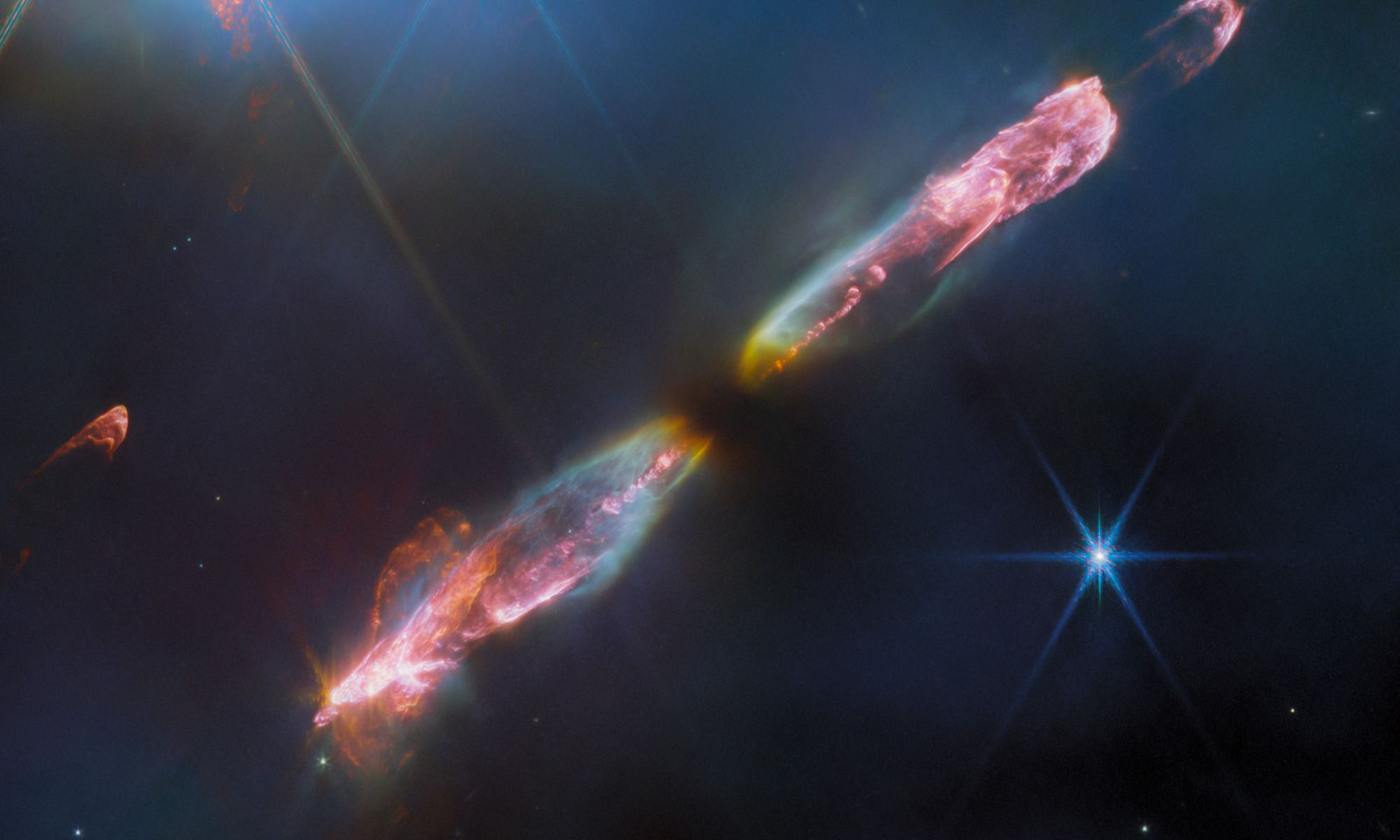Ever wondered what our young Sun might have looked like in its infancy some five billion years ago?
The audacious JWST has captured an image of a very young star much like our young Sun, though the star itself is obscured. Instead, we see supersonic jets of gas. Young stars can blast out jets of material as they form, and the jets light up the surrounding gas. The luminous regions created by the jets as they slam into the gas are called Herbig-Haro Objects.
When a young star forms, it begins inside a giant cloud of gas. The gas begins to collapse due to local instabilities, and the core of a young star forms. As the gas gets denser, the young protostar can’t radiate heat well due to the growing opacity. So the cloud heats up, which stabilizes it and stops the collapsing. But more gas still falls toward the young protostar, and it can’t absorb it all. The gas forms a rotating disk around the protostar.
The young star ejects some of this material from two bipolar jets along the star’s axis of rotation. The details of this process are still being determined, which is why the JWST is studying this Herbig-Haro Object, named Herbig-Haro 211 (HH 211). HH 211 is one of the closest Herbig-Haro objects and is only about 1000 light-years away in the constellation Perseus.
The Webb struggles to see the material in the jets. But the jets excite molecules in the surrounding gas like hydrogen, carbon monoxide and silicon monoxide. These excited molecules emit infrared light, which the JWST’s NIRCam instrument collected.
One of the reasons the JWST was built was to study young stars. Young stars start out inside vast clouds of gas, and when the stars are larger and older, they blow away some of the gas and reveal themselves. The stars are much easier to observe when they evict the gas, but by then, it’s too late to study the young protostar.
The JWST, with its powerful infrared observing capabilities, can see inside these gigantic clouds to watch as young stars and their HH objects go about their business. The JWST reveals more detail than ever in these stellar objects. Its image of HH 211 has almost ten times higher spatial resolution than other images of the same object.
Bow shocks are visible in the lower left and the upper right of the image. The JWST has the power to show us some of the knotty clumps in the visible bow shocks. We can also see the energetic jets coming from the star. They have a symmetrical ‘wiggly’ looking shape which indicates that the infant star might actually be a binary star. (Most HH Objects come from binary stars.) The wiggling is probably from the stars interacting gravitationally with one another.

Thanks to these images and research, combined with older images, scientists determined the speeds involved with these jets, shockwaves, and surrounding matter. The innermost parts of the HH object outflows are moving at about 80 to 100 km/s. This sounds fast but is actually slower than similar outflows from older, more evolved stars.
Speeds are much lower where the outer parts of the outflows collide with the surrounding gas at the bow shocks. Since the material in the jets is so slow when it impacts the gas, there isn’t enough energy to break the molecules apart into their constituent atoms and ions. So the researchers concluded that the jets are molecular. In a more evolved protostar, the higher velocity of the jets would break the molecules apart.

This is an intriguing finding. It indicates that young protostars and their slower jets likely enrich their surrounding environments with complex chemicals. Some of these chemicals are the building blocks for even more complex chemicals, some of which are associated with the appearance of life. Older protostars won’t have the same effect because their faster jets break chemical molecules apart.
HH 211 is a Class 0 protostar, and our Sun went through the same early stage of stellar evolution in its infancy. HH 211 is only about 8% as massive as our Sun but will grow to become a main-sequence star as it attracts more mass. Eventually it’ll be massive enough to trigger fusion and then it’ll leave its protostar stage behind, the jets will disappear, and it’ll clear its vicinity of obscuring gas and dust. Planets will form, too.
Star formation is a big puzzle in astrophysics and is an extremely active area of research. It’s one of the JWST’s primary science goals. One of the conundrums in stellar formation involves the angular momentum problem. As a star forms in a gas cloud, the cloud has some rotation that gives it angular momentum. As the gas collapses inward, the star gains more mass, but the young star’s gravitational pull is eventually balanced by the gas’s growing centrifugal force. This creates a sort of stalemate where the two forces counter each other. To collapse further inward, the system has to shed some angular momentum. This is called the centrifugal barrier, where particles stop moving toward the protostar, and astrophysicists are keen to know more about this and how stars continue to grow.
The image is part of a study in Nature titled “Outflows from the Youngest Stars are Mostly Molecular.” The lead author is Tom Ray, a professor in the School of Cosmic Physics at the Dublin Institute for Advanced Studies.

